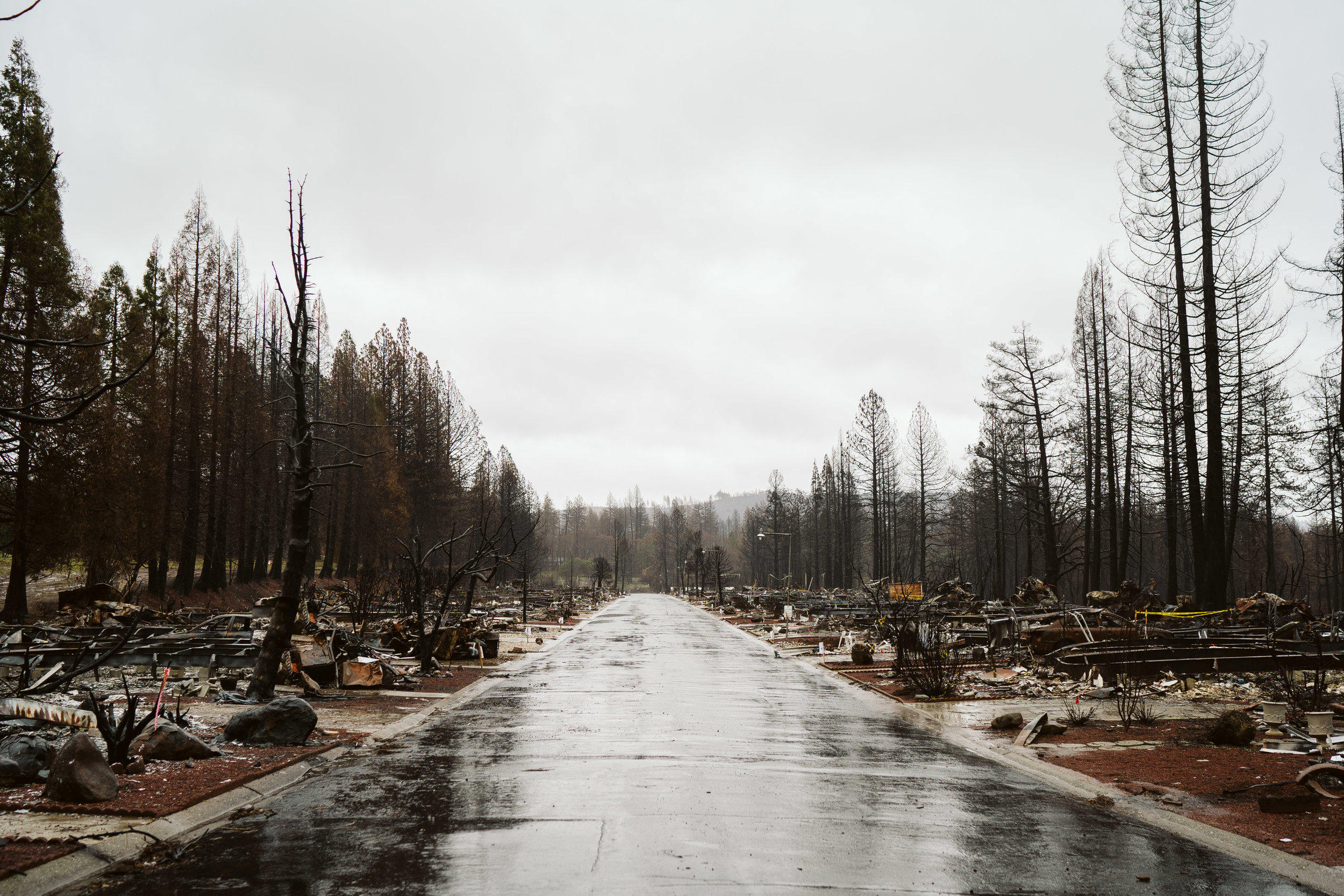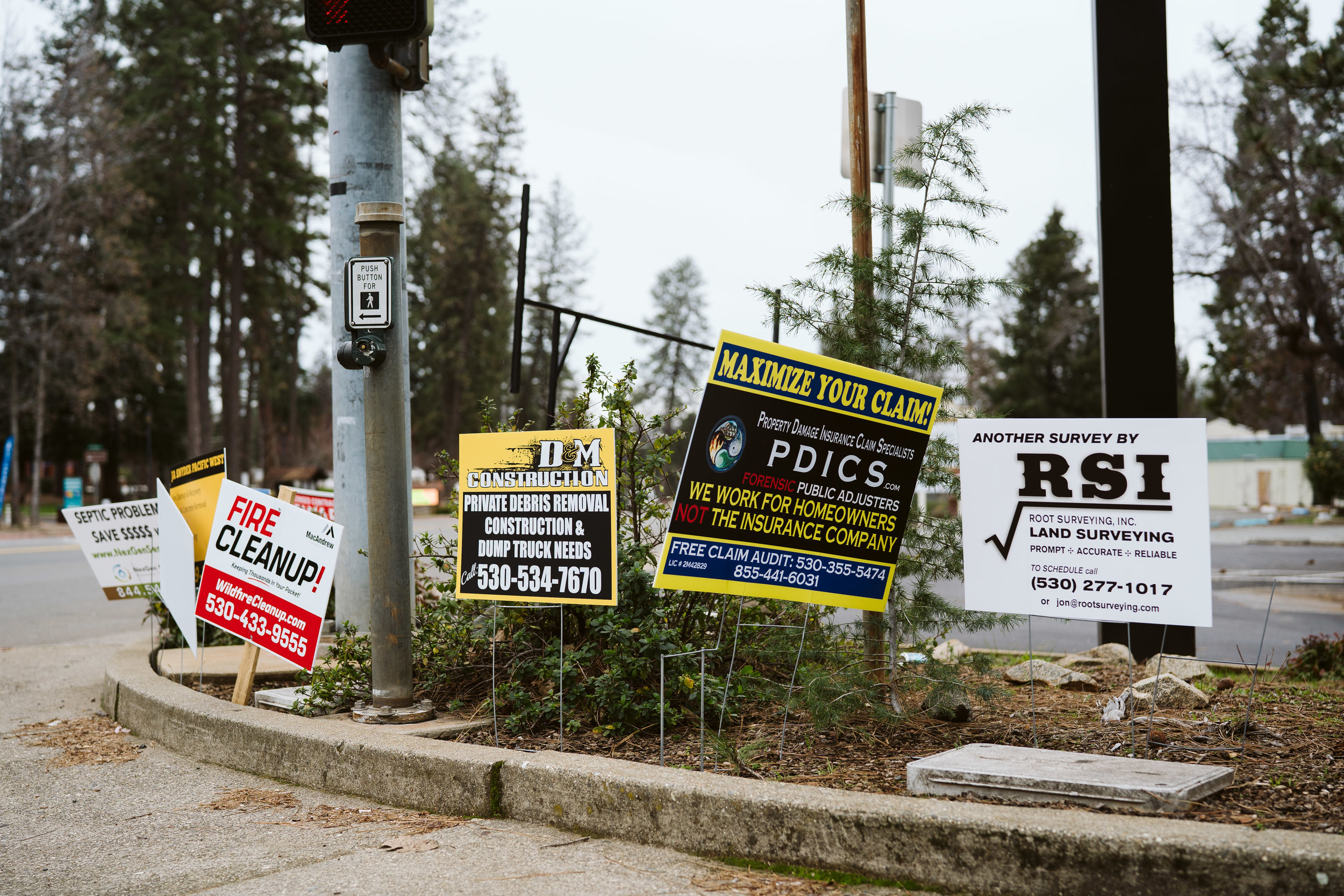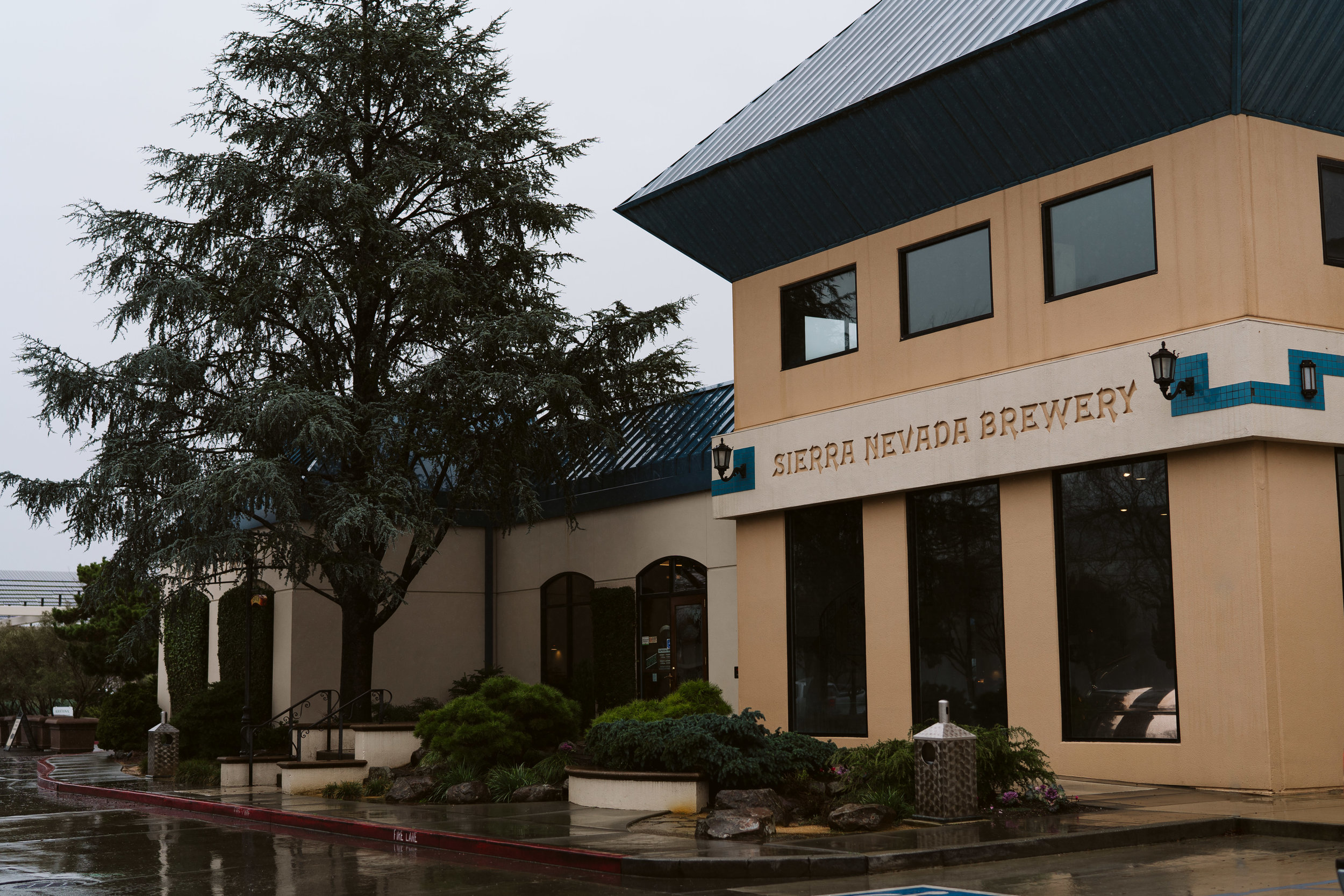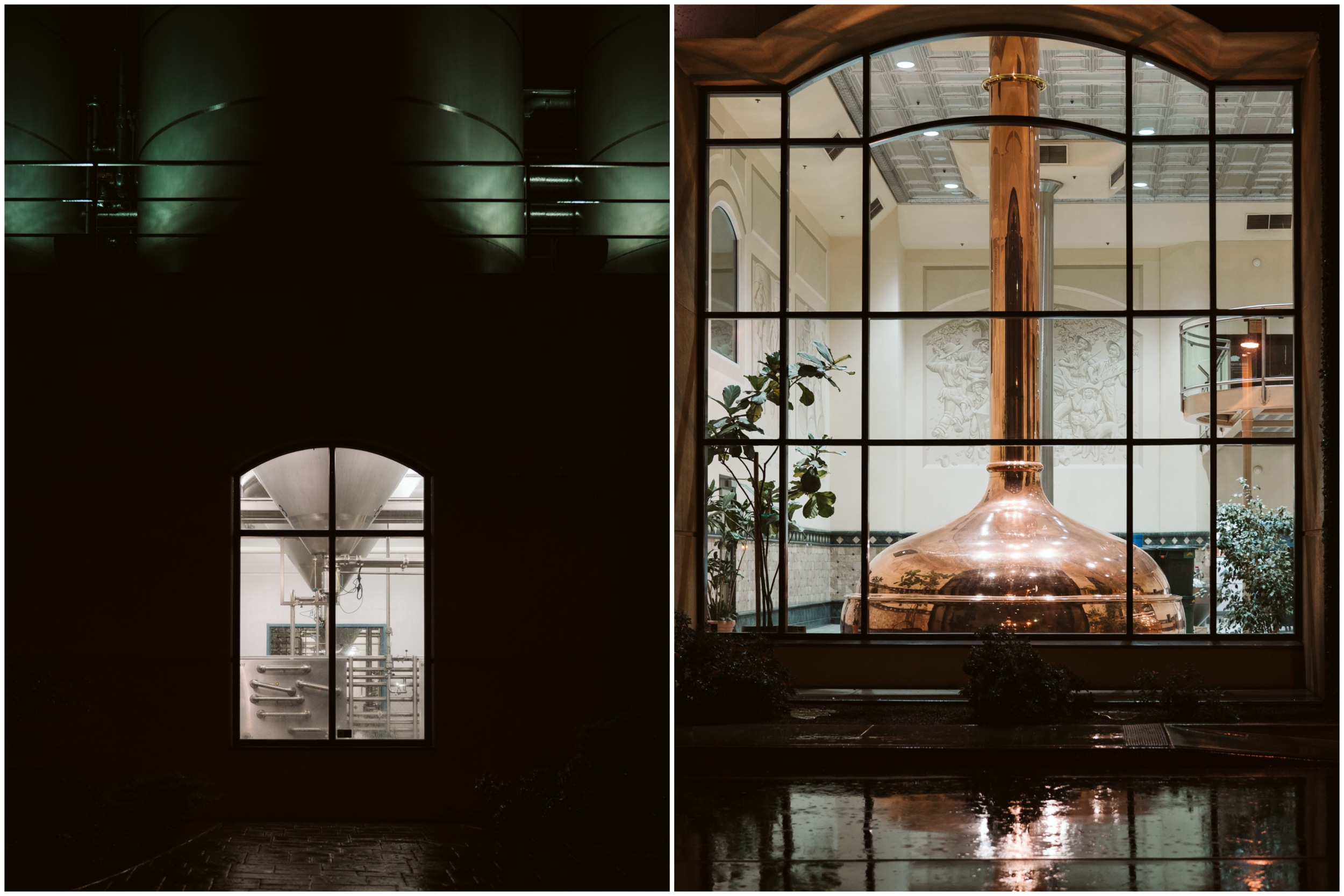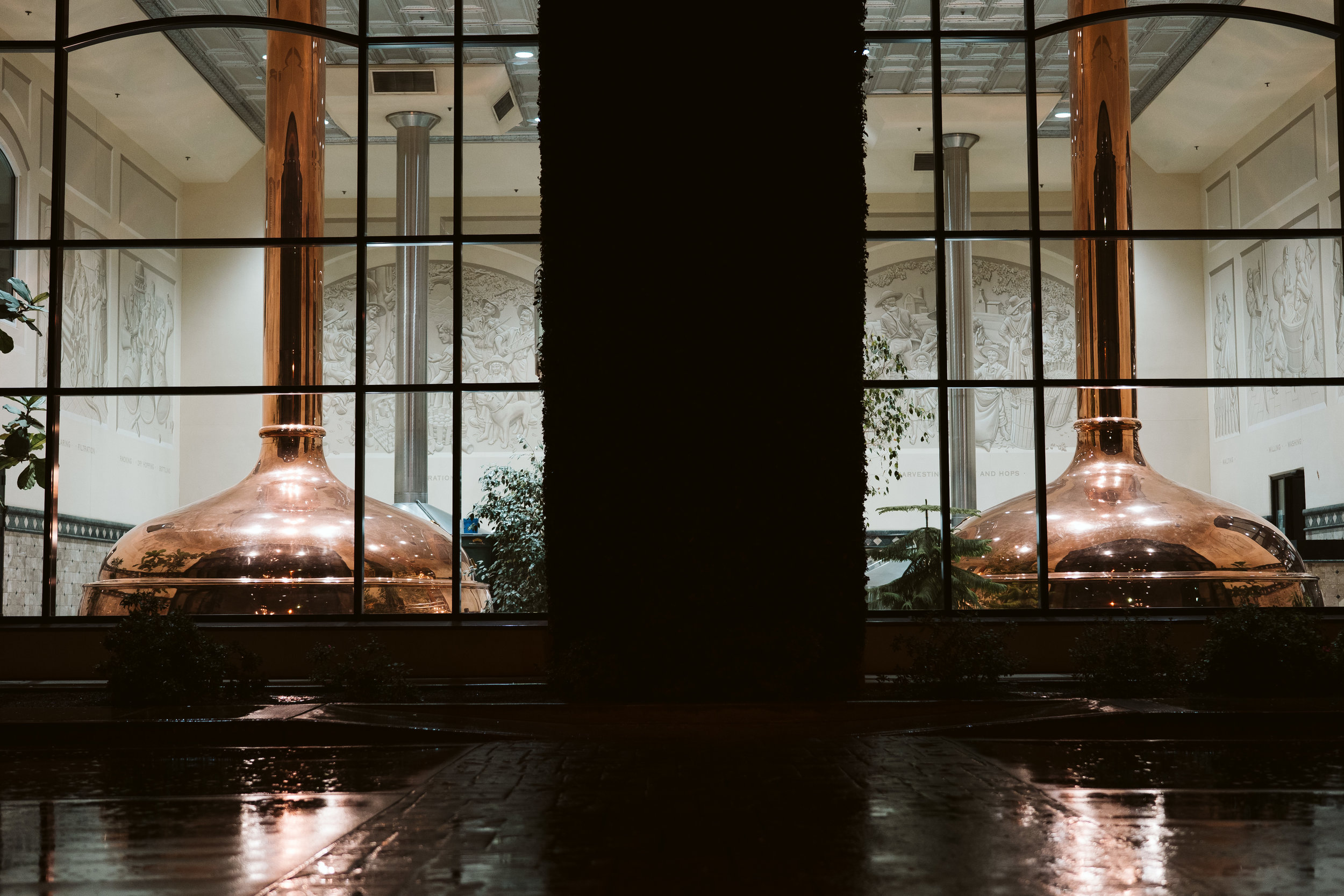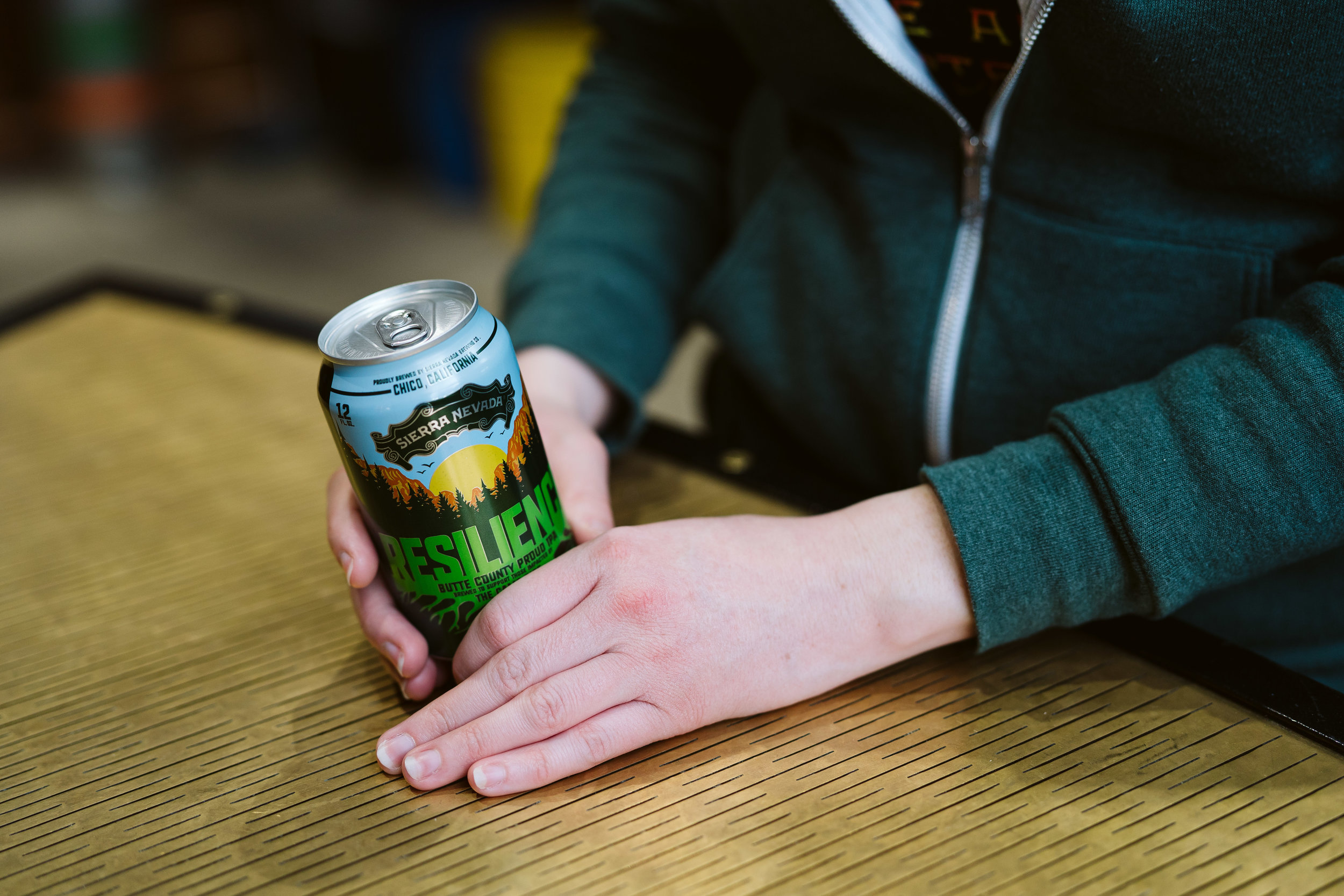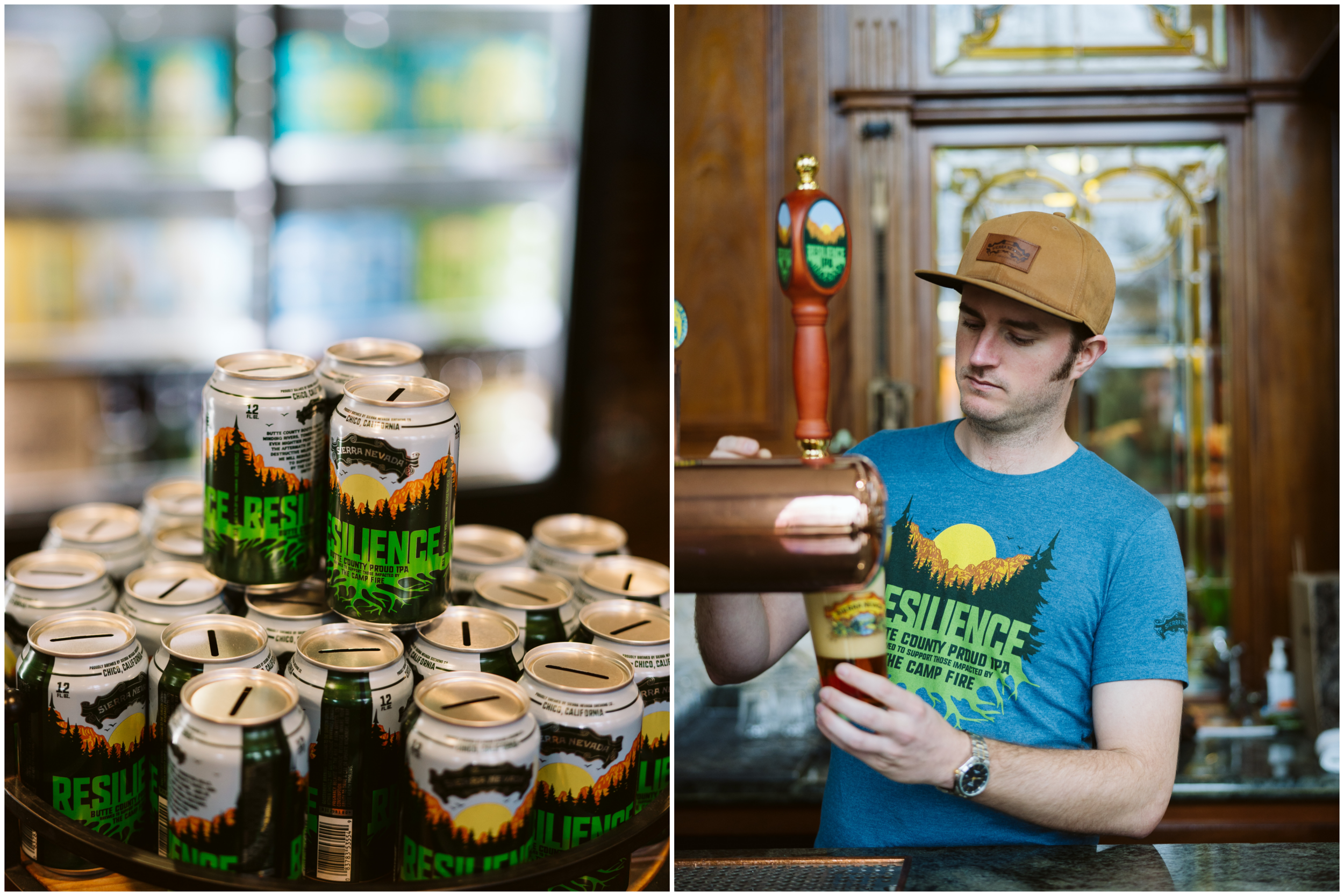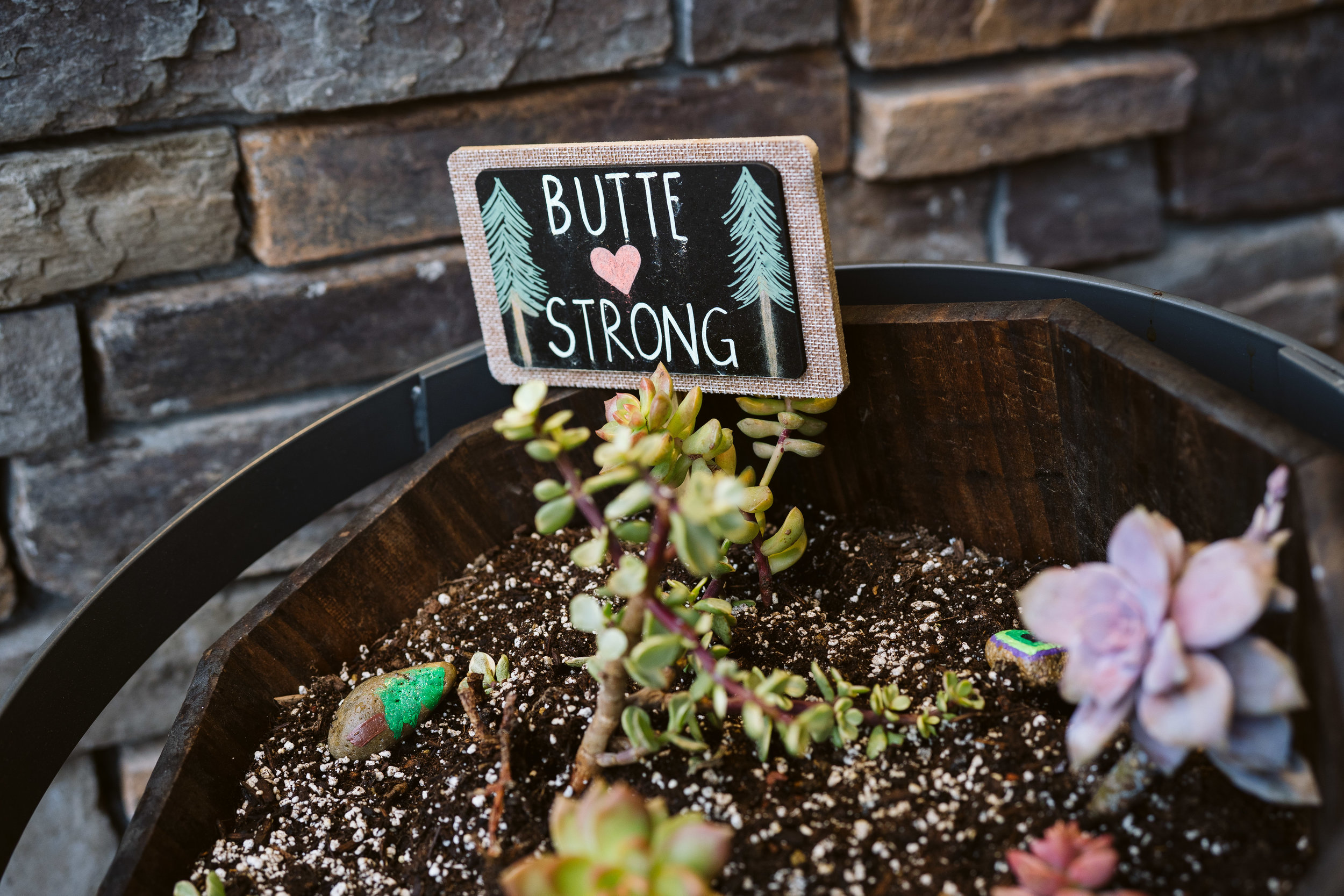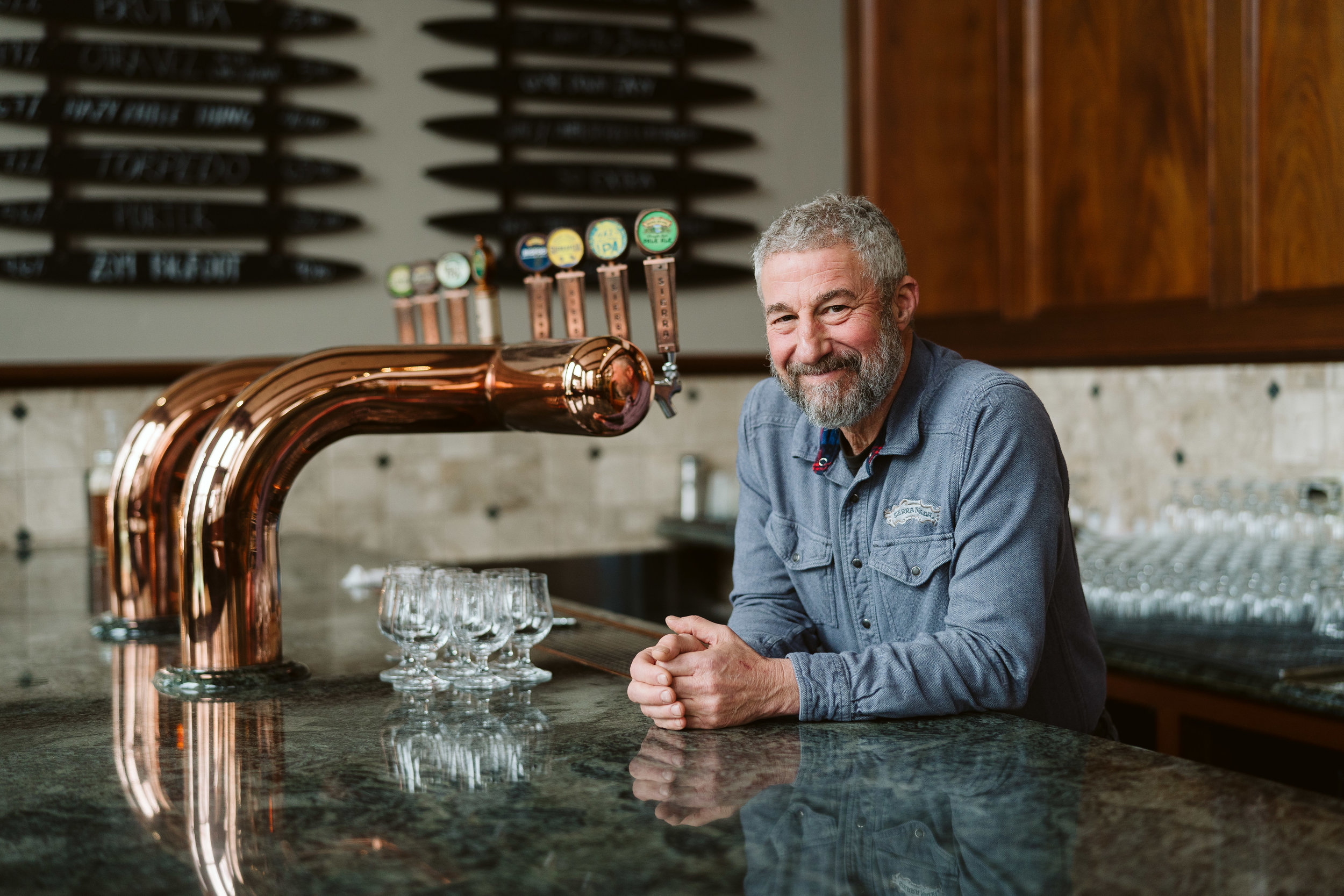It’s a 19-minute drive from Chico to Paradise, California. The road between the two is dotted with new billboards, signs, and handmade posters, most of which reference last November’s disaster. There’s a local lawyer advertising his services to those who lost their homes; private debris removal deals; a series of banners bearing variations of “First Responder, because Superhero isn’t a job title.”
On the right, a short distance south, are makeshift RV parks, delimited by plastic orange poles and caution tape. Heading east, you begin to pass burnt trees and charred, hollowed-out car frames X’d with white spray paint. And then, as you curve right into town: 85 small white and brown crosses, tidily arranged on a lush green lawn.
Each of those crosses represents a life lost to the Camp Fire, which ripped through Butte County beginning on November 8, 2018. It destroyed nearly 19,000 structures over 153,336 acres, and took more than 1,000 firefighters 17 days to contain. It was both the deadliest and most destructive fire in California history.
Less than a week after the blaze began, Sierra Nevada Brewing Company announced Resilience Butte County Proud: a fundraiser to support its Northern California community that would grow to an unprecedented scale.
“I saw the fire right when it started,” says Ken Grossman, founder of Sierra Nevada. Grossman was driving into work at 6:30 a.m. when he noticed something was burning. “Off in the distance, I saw a plume of smoke. Just a single plume of smoke.”
Kory Honea, who serves as sheriff-coroner in Butte County, received the dispatch shortly after 7 a.m. that a fire had sparked in Pulga, around 10 miles northeast of Paradise. Cal Fire had been notified some 20 minutes earlier, but first responders realized they needed assistance with evacuations, based on how quickly the fire was spreading.
“I thought to myself, ‘I can't believe it's November and we're dealing with a wildfire,’” Honea says. “Moving on into the morning I started getting reports about, ‘It is moving rapidly. They're looking at evacuation in Paradise.’”
By 9:30 a.m., Grossman recalls, the fire was on the news and “the whole sky was starting to blacken.” Fire teams, and Honea, were still working to grasp the magnitude of the event.
“In the heat of this battle, you're fighting, waging war against this fire that's consuming ground so rapidly,” Honea explains. “At some point there was some estimation that it was moving, consuming the length of a football field every three seconds or so, and you're in the heat of it. But along with that, there's this fog of war where you're trying to figure out what's going on.”
Honea had dealt with the Oroville Dam spillway incident—another Butte County natural disaster—just two years earlier, and had assumed the likelihood he’d face another event of that severity was slim.
By that night, Honea and Butte County’s first responders had tracked the movement of the fire. It started in Pulga, flew through Concow and then into Paradise.
“Now we're talking about potentially having to evacuate Chico—this fire's going in every direction,” he recalls thinking at the time. “There was this real sense of, ‘Where is this going to stop? Is this going to burn every county in my community?’”
Grossman, meanwhile, like many in the area, was trying to get back to his house to save his pets. His wife Katie was out of town, and taking the advice of friends, he decided to evacuate to Mendocino, three hours west on California’s coast.
“[Leaving] was actually fairly traumatic—the whole town was fleeing and all the gas stations were out of gas,” he remembers. “It was a bit of a panicked scene. I drove alongside the fires—you could see the foothills were on fire. [From] the brewery, looking adjacent, were flames.”
The next day, Grossman, his daughter Sierra, and the Sierra Nevada team worked to locate employees. Many had already lost homes, so Grossman called the mayor of Chico, Randall Stone, to fast track an RV park. Then they got to work on a fundraiser plan. First, it was decided, Sierra Nevada would contribute $100,000 to a charitable foundation for long-term relief. Next: Resilience.
“We reached out right away just to make sure they were okay,” says Natalie Cilurzo, co-founder of Russian River Brewing Company in Santa Rosa, California. She and her husband Vinnie had seen the photos that Sierra Nevada posted of Stygian skies over Chico and were worried. “Having just gone through that ourselves in our community, we [had a] pretty sensitive and heightened awareness of what the aftermath was going to be.”
The Grossmans and the Cilurzos spoke several times over the next few days. Grossman had been inspired by Russian River’s Sonoma Pride beer fundraiser the year before, and wanted to create a similar program to aid in Butte County relief. They discussed what worked and what didn’t, and which facets of the fundraiser they would have done differently.
“Off in the distance, I saw a plume of smoke. Just a single plume of smoke.”
“We just kind of told him our experience with it and the pros and cons,” Cilurzo says. “In typical Sierra Nevada fashion, we did something really cool but then they, of course, took it to the next level. Because they can and they should.”
Specifically, the Cilurzos had found challenges in the administrative aspects of the fundraiser—the excessive time spent signing up breweries, licensing their beer, and distributing raw materials. There were also difficulties in managing where fundraising dollars went; some breweries that participated in Sonoma Pride ended up donating to other fundraisers or not donating the money at all.
“When that’s not what you do for a living, when you’re in a completely different industry altogether, then all of a sudden you decide to take on this big project, you need to be ready for a ton of extra work,” Cilurzo says. “Right away, Ken was like, ‘I have a team that will do it.’”
That team was the same group that puts together Sierra Nevada’s Beer Camp, their annual day of summer camp games, activities, and special brews. But it was still a surreal situation, as Robin Wilkey-Gregory, content manager for Sierra Nevada, recalls.
“One of the key people who handles [events], she lost her home, and I remember her telling me, ‘It’s really odd to be putting this project together when...they’re raising funds for me.’”
The second weekend in November is something of an annual tradition for the Cilurzos and the Grossmans. Both couples typically head to Mendocino: the Cilurzos for a yearly beer dinner, and the Grossmans to celebrate Ken and his wife Katie’s shared birthday—November 11. There’s a simple arrangement: they try to make time to grab beers together. This year, however, the weekend fell two days after the Camp Fire began—and Ken and his son-in-law didn’t make the meeting.
“We just missed them,” Cilurzo says. “They were on their way to check on the houses and brewery and get some more stuff. We didn’t see them. Terrible way to spend your birthday.”
On Monday, three days after the fire began, Sierra Nevada re-opened its pub (and later, the building next door) to exclusively feed first responders. The smoke, however, was still an issue. Turning on the exhaust fans in the kitchen spread acrid fumes through the restaurant.
“We had to go change out all the filters so we could have filtered air in the restaurant,” Grossman recalls. “We changed the filters every day.”
With the community now eating in the pub and being clothed in part by Sierra Nevada’s gift shop, Grossman began planning his fundraiser beer in earnest. He wanted participants to brew an IPA —“I figured IPAs are the number-one style, we should do an IPA”—so his staffers put together a packet of information, which included a recipe for a West Coast IPA in the Sierra tradition.
Then he got to work on three letters. The first was addressed to the brewery’s suppliers.
One of the recipients was Country Malt Group. “[Grossman] sent us a personal note asking if we would support this,” says Tara Kambeitz, a director of marketing with the company. “There was no debate over it. It was more, ‘What are we going to do?’ and ‘How much?’ was more the question.”
BSG and Admiral Maltings signed on, among other maltsters. So did Yakima Chief Hops, Haas, and Crosby Hop Farm.
“Every member of their company who lost a home—and they had a lot of people lose homes—got to throw some of the hops into the brew, into the kettle.”
“I picked some hop varieties I knew would be in inventory,” Grossman explains. “I made personal calls to all the hop suppliers, maltsters, put together a letter and sent that to all those folks as well.”
Another letter went to wholesale partners, and the last to brewers. Some had already reached out—Grossman remembers that besides Russian River, he got early calls from Trumer and Rogue—but Sierra Nevada’s staff was still gauging interest from other breweries nationwide. Grossman was hoping to attract 200 breweries to the cause, with the goal of raising $2 million. But social media has a way of spreading things.
“Initially we thought it might be better if we posted it on Facebook [to] say, ‘Hey, send us a direct message if you’re a brewer and want to do [a Resilience beer],’” says Wilkey-Gregory. “It was on a Friday afternoon when we posted that. On Saturday morning, our social media manager called me and said we have hundreds of messages from breweries—he’d answer 10 and then he’d get out and there would be 20 more. They were literally coming in faster than he could answer them.”
To keep things organized, the events team created a Formstack, which included a sign-up form and enabled them to keep track of which breweries were participating, how much they were planning to brew, and how much they hoped to donate.
“It was a bit shocking,” Grossman says. “Within a few days, I think we hit 400–500. It was like wow, maybe we could get to a thousand. Every day it was very exciting [to see] the number of people jumping onboard.”
The number was both invigorating and daunting—particularly so for Country Malt Group. The company had prepared for the possibility that a fundraiser launched by someone as integral to the beer industry as Grossman could become a colossal and costly endeavor for a raw materials company. But they signed on anyway.
“There was discussion, like this could be really big,” Kambeitz says. “We still said yes, we will support it 100%. Any brewery that wants to brew the beer and donate all the proceeds can have their malt ingredients provided by us for free.”
Country Malt Group would go on to send almost 3,000 bags of malt—roughly 73 metric tons—to around 200 breweries. Altogether, Kambeitz estimates the cost of everything came close to $120,000.
While participating breweries continued to sign up to brew a Resilience beer, the Camp Fire had still not been completely contained by the time Thanksgiving arrived on November 22. The evacuated people of Paradise and its surrounding areas had largely relocated to shelters, hotels, and temporary housing around Northern California. So Grossman and the Sierra Nevada staff decided to invite them over.
Cooks, staffers, and friends—including Vinnie and Natalie Cilurzo—prepared and served food to nearly 2,000 people. Altogether they made 75 gallons of gravy, 1,800 pounds of turkey, and 1,500 pounds of potatoes.
Natalie Cilurzo recalls Grossman getting his hands dirty that day. “He boiled potatoes in the old brewhouse,” she says. “It was hilarious.”
Also among the dinner’s attendees was Sheriff Honea. Anxiety was everywhere, he remembers, but the overall feeling in the air was, perhaps fittingly, gratitude.
“I was pretty amazed at how the people were so receptive to me being there,” he says. “We'd talk about how they lost everything, but the overwhelming sentiment was, ‘We're thankful to be alive…we're going to get through this and we're going to rebuild at some point.’ That was what struck me when I was there at Sierra Nevada.”
While at the event, Honea, who is a self-described craft-beer guy, was particularly excited to meet Terence Sullivan, Sierra Nevada’s brewery ambassador. The two recognized each other instantly. Honea knew Sullivan because he had seen him in Sierra Nevada’s Facebook videos, and Sullivan had seen Honea on the local news delivering updates to the community during fire coverage.
“I think it was a couple of days later, [Sullivan] gave me a call and said, ‘Hey, we're brewing [Resilience], would you want to come down and help throw some hops into the brew?’” Honea says. “To be a small part of that was a huge honor.”
Sierra Nevada planned its Resilience Brew Day for five days after Thanksgiving, on Giving Tuesday, November 27. All brewers who had signed up to participate in the fundraiser were invited to remotely take part.
Moksa Brewing Company in Rocklin, California—roughly 85 miles south of Paradise—jumped at the chance to brew Resilience. For brewers Derek Gallanosa and Cory Meyer, it was personal: the two had inhaled the fire’s smoke as it drifted down the state. In the days following the beginning of the Camp Fire, Northern California was found to have the worst air quality in the world.
“I remember the smoke was so thick I could stare straight at the sun and it was just this dim bulb,” Meyer says. “I’ve never seen anything like it.”
Moksa brewed 10 barrels of its version of Resilience, and to date, the founders say, it’s one of their fastest-moving beers. They didn’t put limits on purchases like they do for some of their more popular styles, so people were “coming in buying four, six, nine growlers at a time,” Gallanosa says. “The faster we could write the check, the better.” They ended up donating $7,300 to the fund.
Final Draft Brewing Company in Redding, California had just weathered the deadly Carr Fire a year prior to the Camp Fire. The brewery had made a beer for that cause, so founder Adam Ward says “there was no hesitation at all” when Sierra Nevada put out the call for help with its fire relief.
“I think this Resilience fundraiser could be one of the most successful fundraisers ever—not just in the beer community but anywhere.”
“When the Camp Fire broke out, we were all heartbroken for the families that were left with nothing in the wake of the devastation,” he says, noting they would go on to donate $5,700. “We knew we wanted to be on board to help.”
On the opposite side of the country, Cigar City Brewing brand ambassador Neil Callaghan says “there was no question that we'd do everything we could for Sierra Nevada and for the Butte County community.”
“We've dealt with plenty of natural disasters here in Florida,” he says, “and we know how much it means to have support from friends across the country.”
When Sierra Nevada wrote that initial Facebook post asking the community for help, one of the first to respond was Portland, Oregon’s Ex Novo Brewing Co. Founder Joel Gregory says he “got chills thinking of what the community of Paradise went through.” Ex Novo donated $9,700 in the hopes that “it finds its way to someone in need.”
Jos Ruffell, too, understands the havoc fires can wreak. The co-founder of Garage Project in Wellington, New Zealand, he was also one of the first to comment on Sierra Nevada’s post about the Resilience brewing effort. As Ruffell says, part of the reason he wanted to get involved was because wildfires are an issue that affects his brewery, too. Recently, Garage Project’s local hop-growing region was threatened by one of the largest fires in its history.
“We’ve got to know the team at Sierra Nevada well through Beer Camp collaborations, where they went to incredible lengths to welcome us, host us, share knowledge, and help our own brewery in New Zealand,” he says. “It’s the type of camaraderie that makes craft beer so special, and ultimately it’s about the people, so naturally we want to be there to support our friends.”
Back in Chico, Sheriff Honea arrived at the brewhouse on the Resilience brew day. A number of Sierra Nevada employees were there, he recalls, including those whose houses had burned down in the fire. Together, they took part in an impromptu moment of remembrance.
“Every member of their company who lost a home—and they had a lot of people lose homes—got to throw some of the hops into the brew, into the kettle,” Honea remembers. “Then at the very end, I threw some in and then Ken threw some.”
The day the beer was released, the staff had initially allocated 500 cases of the more than 4,000 barrels of Resilience they brewed to the brewery gift store. But, as Grossman observed, “We had a line going down the street.” Within the first few hours of the release, they had sold 700 cases.
By mid-December, news would break that more than 1,400 breweries—a quarter of all American breweries at the time—had signed on to make Resilience.
The North Valley Community Foundation teamed up with Sierra Nevada in early January, two months after the fire began. The foundation had actually opened within the first few hours of the fire sparking, says Alexa Benson-Valavanis, president and CEO of the organization, but it wasn’t until early 2019 that three fundraisers—their own Camp Fire Relief Fund, Chico-born Green Bay Packers quarterback Aaron Rodgers’ NorCal Recovery Fund, and Sierra Nevada’s Resilience project—joined together to form the Butte Strong Fund.
“When you look at the role of philanthropy, it's really critical,” she says. “Because [it’s] unlike the other funding sources that oftentimes take a considerable amount of time and energy to get out in the world. With our funds here, we can get the money out quickly.”
By early February, the NVCF had already granted $6 million towards immediate needs, like the hiring of city planners for Paradise, school transport for children living away from their homes, and a short-term housing relocation program.
It’s the largest project Benson-Valavanis has ever handled. In total, the NVCF anticipates that the fund could bring in up to $45 million dollars. For the sake of comparison, in the last fiscal year, the foundation granted just $3 million.
“The Community Foundation transformed overnight to become a disaster-relief organization because of the severity of this, and its proximity to the communities that we serve,” she explains.
In downtown Paradise, there are roadside store signs still standing in front of collections of singed bricks. There are melted gas stations and piles of debris near picket-sign flyers offering words of encouragement. Inside a somehow-unscathed Starbucks on Skyway Road sits an empty can of Sierra Nevada’s Resilience IPA, now potted with a germinal succulent.
“Chico has been our community from our inception,” Grossman says. “I’ve been here over 40 years, so I certainly have a real connection with the community and the foothills that were impacted. We have a lot of employees who don’t have homes and who were displaced. For us it was just part of who we are as a company, trying to help those in need.”
The next stage of recovery is an awkward one. As the initial sentiment of unity through calamity fades away and wreckage clears, some locals are seeking to prematurely return to normalcy.
“A couple months down the road, [we’re] seeing, ‘I don’t really want that debris removal site in my backyard,’ ‘I don’t want 500 FEMA trailers in my neighborhood,’” Wilkey-Gregory says. “[We’re] seeing this city work through that awkward and challenging process of how to recover in a sustainable way.”
But Sierra Nevada hopes, by the end of the fundraiser, to put $15 million toward long-term recovery efforts. It’s a sum that stands in stark contrast to Grossman’s initial $2-million goal. Cilurzo, who’s watched since the fires began, has an idea of how much work it’s taken to get Resilience to this point.
“I think this Resilience fundraiser could be one of the most successful fundraisers ever,” she says. “Not just in the beer community, but anywhere.”
Grossman says he’s surprised it’s attracted this much attention.
“That’s a true testament to how humble he still is after all these years,” Cilurzo adds. “But we’re not surprised. Sierra Nevada is the beer that most brewers cut their teeth on and it’s the beer many of us grew up with...I’m really, really happy they’ve had such a great response.”
For an outdoorsman like Grossman, the fire has been a tragedy on two fronts: it’s been devastating to see both his community burn as well as the land around it. “I used to cycle through Paradise almost every week for quite a few years,” he says. “I haven’t been on my bike back there, but one of these days I’ll get back.”
